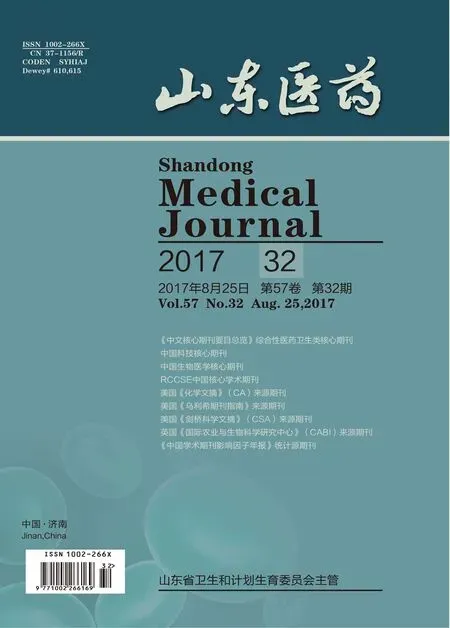PRPS2对肺癌细胞体外生长、增殖和体内成瘤的影响及其机制
顾鸿莉,宋卫峰,王静珏,蔡讯,李琦
(上海交通大学附属第一人民医院,上海200080)
PRPS2对肺癌细胞体外生长、增殖和体内成瘤的影响及其机制
顾鸿莉,宋卫峰,王静珏,蔡讯,李琦
(上海交通大学附属第一人民医院,上海200080)
目的探讨磷酸核糖焦磷酸合成酶2(PRPS2)对肺癌细胞体外生长、增殖和体内成瘤的影响及其机制。方法将体外培养的肺癌A549细胞随机分为对照组、Lenti-sh1组、Lenti-sh2组,分别感染scramble序列慢病毒及能够沉默PRPS2基因表达的慢病毒Lenti-sh1、Lenti-sh2,作用时间均为12 h,结果显示Lenti-sh1组、Lenti-sh2组PRPS2 mRNA及蛋白表达均低于对照组(P均<0.05),说明慢病毒可抑制A549细胞PRPS2基因表达,该分组及处理方法可用于以下研究。采用克隆形成实验检测三组细胞形成的克隆数量,CCK-8法检测细胞增殖能力(吸光度值),流式细胞术检测细胞周期,RT-PCR法及Western blotting法检测Wnt信号通路中的关键基因β-连环蛋白(β-catenin)、APC、糖原合成酶激酶3β(Gsk-3β)mRNA和蛋白表达。将18只裸鼠随机分成3组,分别接种对照组、Lenti-sh1组、Lenti-sh2组细胞,每组6只;接种6周时剥离瘤体称重,并测量体积。结果Lenti-sh1组、Lenti-sh2组细胞形成的克隆数量均少于对照组(P均<0.05);培养72、96 h时,Lenti-sh1组、Lenti-sh2组细胞吸光度值均低于同时间点对照组(P均<0.05)。Lenti-sh1组、Lenti-sh2组G0/G1期细胞比例均高于对照组,S期、G2/M期细胞比例均低于对照组(P均<0.05)。Lenti-sh1组、Lenti-sh2组Wnt信号通路中的关键基因β-catenin、APC mRNA和蛋白相对表达量均低于对照组,Gsk-3β mRNA和蛋白相对表达量均高于对照组(P均<0.05)。接种对照组细胞的裸鼠瘤体质量及体积均大于接种Lenti-sh1组、Lenti-sh2组细胞的裸鼠(P均<0.05)。结论沉默PRPS2基因可抑制肺癌细胞的体外生长、增殖,减弱体内成瘤能力;调控Wnt信号通路可能是其作用机制。
肺癌;磷酸核糖焦磷酸合成酶2;细胞增殖;细胞周期;体外成瘤能力
Abstract:ObjectiveTo investigate the role of phosphoribosyl pyrophosphate synthetase 2 (PRPS2) in lung cancer cell proliferation, tumor growth in vitro, and tumorigenic ability in vivo.MethodsLung cancer A549 cells cultured in vitro were divided into 3 groups: the control group (scramble control shRNA lentivirus infecting cells for 12 h), Lenti-sh1 group (lentivirus Lenti-sh1 infecting cells for 12 h) and Lenti-sh2 group (lentivirus Lenti-sh2 infecting cells for 12 h). These results indicated that the mRNA and protein expression levels of PRPS2 were effectively reduced in the control group as compared with that of the other two groups (bothP<0.05). These results indicated that the expression levels of PRPS2 were reduced by PRPS2 shRNA lentivirus in A549 lung cancer cells. Colony formation assay was used to detect the clone number of three groups. The cell proliferation rate was evaluated by a CCK8 assay and cell cycle was detected by flow cytometry. RT-PCR and Western blotting were used to detect the mRNA and protein expression levels of APC, β-catenin, Gsk3β in A549 cells of WNT signaling pathway. Tumors were generated by subcutaneously injecting lung cancer A549 cells from the control, Lenti-sh1 and Lenti-sh2 groups into the right forelimb axillaries of Balb/c nude mice (each group contained 6 mice). The mice were sacrificed at the 6th week to evaluate the weight and volume of tumors.ResultsCompared with the control group, the number of cell colonies in the Lenti-sh1and Lenti-sh2 groups were reduced (P<0.05). The absorbance value of the Lenti-sh1and Lenti-sh2 groups at 72 and 96h was lower than that of the control group (P<0.05). A significantly higher percentage of cells accumulated in the G0/G1phase of the cell cycle in the Lenti-sh1and Lenti-sh2 groups as compared with that of the control group. However, the percentage of cells in the S and G2/M phase was lower than that of the control group (allP<0.05). The mRNA and protein levels of APC and β-catenin in the Lenti-sh1and Lenti-sh2 groups were lower than that of the control group but the mRNA and protein levels of Gsk-3β were higher than that of the control group (allP<0.05). The tumor weight and volumes of the the Lenti-sh1and Lenti-sh2 groups decreased significantly as compared with those of the control group (bothP<0.05).ConclusionSilencing PRPS2 gene may suppress lung cancer growth, proliferation in vitro, and tumorigenic ability in vivo by regulating the WNT signaling pathway.
Keywords: lung carcinoma; phosphoribosyl pyrophosphate synthetase 2; cell proliferation; cell cycle; tumorigenic ability in vitro
肺癌是呼吸系统常见恶性肿瘤,发生机制尚未明确。磷酸核糖焦磷酸合成酶(PRPS)是核苷酸合成过程的关键酶,由PRPS基因家族编码[1]。PRPS2基因作为髓细胞增生原癌基因(c-myc)的作用靶点,其表达水平随c-myc表达降低而下降。c-myc基因表达下调可诱导多种细胞凋亡[2],参与肿瘤的发生、发展,提示PRPS2可能与肿瘤细胞的增殖及凋亡有关。2015年9月~2016年4月,本研究观察了PRPS2对肺癌细胞增殖和肿瘤生长的调控作用,现分析结果并探讨其机制。
1 材料
肺癌细胞株A549(下称A549细胞)购自中科院上海细胞库。18只BALB/c裸鼠购自上海SLAC实验动物公司,5周龄,平均体质量15 g。Bradford蛋白浓度检测试剂盒、CCK-8试剂盒购自上海碧云天生物科技有限公司。Annexin V-FITC/PI细胞周期检测试剂盒购自凯杰生物工程有限公司。PRPS2-shRNA慢病毒载体购自上海吉凯基因科技有限公司。
2 方法与结果
2.1 体外实验
2.1.1 细胞培养及分组处理 将A549细胞培养于含有10% FBS、100 U/mL链霉素、100 U/mL青霉素的RPMI 1640培养基,取对数生长期细胞随机分为对照组、Lenti-sh1组及Lenti-sh2组。对照组感染表达scramble序列的慢病毒,Lenti-sh1组感染能够沉默PRPS2基因表达的慢病毒Lenti-sh1,Lenti-sh2组感染能够沉默PRPS2基因表达的慢病毒Lenti-sh2,作用时间均为12 h。
2.1.2 细胞PRPS2表达检测 ① PRPS2 mRNA表达检测:采用RT-PCR法。取各组细胞逆转录为cDNA。PCR体系为50 μL,包括25 μL MasterMix、上下游引物各0.5 μL、cDNA模板5 μL、去离子水19 μL。PCR条件:95 ℃、15 s,60 ℃、30 s,共40个循环。引物序列由上海生工生物工程股份有限公司合成。以酶标仪检测PRPS2 mRNA扩增产物电泳条带的吸光度(A)值,以GAPDH为内参,计算目的基因相对表达量。②PRPS2蛋白表达检测:采用Western blotting法。取三组细胞,采用RIPA细胞裂解液冰上裂解30 min,加入相应比例蛋白上样缓冲液,沸水浴10 min;分别取30 μg蛋白加预制胶,50 V恒压下电泳;待样本中溴酚蓝跑至浓缩胶与分离胶分界线时,切换至120 V恒压;溴酚蓝跑至胶板底部时,400 mA恒流将蛋白样本转至PVDF膜上;加入PRPS2一抗,37 ℃孵育4 h;加入二抗孵育过夜;ECL液显影,Quantity One 1-D分析软件对蛋白质印迹条带进行定量,计算目的蛋白相对表达量。结果显示,对照组、Lenti-sh1组、Lenti-sh2组PRPS2 mRNA相对表达量分别为1.00±0.23、0.35±0.01、0.30±0.03,PRPS2蛋白相对表达量分别为1.00±0.01、0.64±0.04、0.52±0.02,Lenti-sh1组、Lenti-sh2组均低于对照组(P均<0.05);说明慢病毒可以抑制A549细胞PRPS2基因及蛋白表达。该分组及处理方法可用于以下研究。
2.1.3 细胞形成克隆数量检测 采用克隆形成实验。将三组细胞分别消化并制备单细胞悬液,显微镜下计数。以密度为500个/孔接种于6孔板,每2天换1次液。细胞培养9天时用移液器去除培养基并用PBS洗1遍,每孔中加入500 μL 4%多聚甲醛固定10 min;吸去多聚甲醛,PBS清洗1遍,每孔加入500 μL结晶紫染色液,常温下染色5 min;吸去染色液, PBS清洗3遍,显微镜下观察拍照,统计三组细胞形成的克隆数量。结果显示,对照组、Lenti-sh1组、Lenti-sh2组细胞形成的克隆数量分别为(144±19)、(57±14)、(64±21)个,Lenti-sh1组、Lenti-sh2组均少于对照组(P均<0.05)。
2.1.4 细胞增殖能力检测 采用CCK-8法。将三组细胞分别制备成单细胞悬液,显微镜下计数。以密度为1×103个/孔接种于96孔板,分别在培养0、12、24、48、72、96 h时加入10 μL CCK-8溶液,继续培养1 h,在酶标仪上测定450 nm处A值。结果显示,培养72、96 h时,Lenti-sh1组、Lenti-sh2组细胞A值均低于对照组(P均<0.05)。见表1。

表1 三组各时间点细胞增殖能力比较
注:与对照组同时间点比较,*P<0.05。
2.1.5 细胞周期检测 采用流式细胞术。将三组细胞分别制备成单细胞悬液,4 ℃下300 g离心5 min,收集细胞并用预冷的PBS洗涤细胞2次。分别用流式管收集1×104~5×104个细胞,加入100 μL 1×Binding Buffer重悬细胞成为单细胞悬液;分别加入5 μL Annexin V-FITC和5 μL PI Staining Solution,轻轻混匀,室温避光反应10 min;分别加入400 μL 1×Binding Buffer,用移液器轻轻吹打、混匀,放置于冰上,1 h内采用流式细胞仪检测细胞周期。结果显示,Lenti-sh1组、Lenti-sh2组G0/G1期细胞比例均高于对照组,S期、G2/M期细胞比例均低于对照组(P均<0.05)。见表2。

表2 三组细胞周期中各期细胞比例比较
注:与对照组比较,*P<0.05。
2.1.6 APC、β-连环蛋白(β-catenin)、糖原合成酶激酶3β(Gsk-3β)mRNA和蛋白表达检测 采用RT-PCR法、Western blotting法。具体方法参照2.1.2。结果显示,Lenti-sh1组、Lenti-sh2组Wnt信号通路中的关键基因APC、β-catenin mRNA和蛋白相对表达量均低于对照组,Gsk-3β mRNA和蛋白相对表达量均高于对照组(P均<0.05)。见表3。

表3 三组APC、β-catenin、Gsk-3β mRNA和蛋白相对表达量比较
注:与对照组比较,*P<0.05。
2.2 体内实验 将2.1.1中三组细胞采用胰蛋白酶进行消化,调整细胞数量后重悬为单细胞悬液。将18只裸鼠随机分成3组,每组6只;采用注射器在右前腋窝下分别注射对照组、Lenti-sh1组、Lenti-sh2组细胞(体积为300 mL,数量为1×107个)。细胞接种6周时采用断颈法处死荷瘤小鼠,用手术剪和镊子剥离瘤体称重并测量体积。结果显示,接种对照组、Lenti-sh1组、Lenti-sh2组细胞的裸鼠瘤体质量分别为(0.94±0.17)、(0.31±0.09)、(0.33±0.11)g,瘤体体积分别为(0.76±0.12)、(0.25±0.10)、(0.32±0.12)cm2,接种对照组细胞的裸鼠瘤体质量及体积均大于接种Lenti-sh1组、Lenti-sh2组细胞的裸鼠(P均<0.05)。
3 讨论
肿瘤细胞的无限增殖依靠充足的蛋白质、糖类物质以及核酸的合成,代谢相关产物如核酸对肿瘤细胞的生长、增殖等发挥重要的调控作用[7,8]。核酸合成过程中的关键酶通过调节核酸的合成速度调控肿瘤细胞的生长、增殖。磷酸核糖焦磷酸(PRPP)合成的关键酶PRPS2是耦合蛋白质和核苷酸生物合成的限速酶之一,其在细胞内的浓度受到严格调控,生理状态下其浓度一般较低,参与嘌呤核苷酸与嘧啶核苷酸的从头合成和补救合成,以及某些核苷酸类辅酶如辅酶Ⅰ和辅酶Ⅱ,某些氨基酸如组氨酸和色氨酸的合成[9,10]。研究发现,PRPS2能促进癌基因c-myc转录,进而促进肿瘤细胞内的核苷酸合成[11]。PRPS2功能缺失延迟体内c-myc依赖的肿瘤细胞的启动和维持,敲除PRPS2基因可抑制肿瘤进展[12]。5-磷酸核糖是嘌呤、嘧啶、吡啶核苷酸生成通路中的关键物质[4,5]。PRPS2在催化ATP和5-磷酸核糖合成PRPP的过程中发挥重要作用[13~15]。研究发现,PRPS2在结直肠癌、多形性胶质母细胞瘤、急性淋巴细胞白血病等癌组织及细胞中高表达[6],可促进肿瘤的发生、发展。但PRPS2与肺癌发生、发展的关系鲜见报道。
本研究首先以A549细胞为研究对象,采用慢病毒介导的RNA干扰技术沉默 PRPS2表达,结果显示通过慢病毒Lenti-sh1、Lenti-sh2沉默PRPS2基因表达的肺癌细胞形成的克隆数量减少,增殖受到抑制,细胞周期明显阻滞。进一步采用裸鼠成瘤实验在体内验证PRPS2对肺癌生长的调控作用,结果显示沉默PRPS2表达的A549细胞成瘤能力明显减弱。以上结果均说明,沉默PRPS2基因表达可抑制肺癌的发生及发展。Wnt信号通路在肺癌生长和转移过程中发挥重要作用,但它的上游调节因子仍有待阐明。APC、β-catenin、GSK-3β是Wnt信号通路中的关键基因,共同介导细胞的增殖和凋亡过程[3]。本研究结果显示,沉默PRPS2基因的肺癌细胞Gsk-3β mRNA和蛋白表达均增加,APC及β-catenin表达均降低;提示PRPS2可能通过调控Wnt信号通路而发挥作用。
综上所述,沉默PRPS2基因可抑制肺癌细胞的体外生长、增殖,减弱体内成瘤能力;调控Wnt信号通路可能是其作用机制。
[1] Robusto M, Fang M, Asselta R, et al. The expanding spectrum of PRPS1-associated phenotypes: three novel mutations segregating with X-linked hearing loss and mild peripheral neuropathy[J]. Eur J Hum Genet, 2015,23(6):766-773.
[2] Annava S, Grachtchouk V, Wheeler LJ, et al. Direct role of nucleotide metabolism in C-MYC-dependent proliferation of melanoma cells[J]. Cell Cycle, 2008,7(15):2392-2400.
[3] Kase S, Sugio K, Yamazaki K, et al. Expression of E-cadherin and beta-catenin in human non-small cell lung cancer and the clinical significance[J]. Clin Cancer Res, 2000,6(12):4789-4796.
[4] Cordenonsi M, Zanconato F, Azzolin L, et al. The Hippo transducer TAZ confers cancer stem cell-related traits on breast cancer cells[J]. Cell, 2011,147(4):759-772.
[5] Iizasa T, Taira M, Shimada H, et al. Molecular cloning and sequencing of human cDNA for phosphoribosyl pyrophosphate synthetase subunit Ⅱ[J]. FEBS Letters, 1989,244(1):47-50.
[6] Cairns RA, Harris IS, Mak TW. Regulation of cancer cell metabolism[J]. Nat Rev Cancer, 2011,11(2):85-95.
[7] Green CD, Martin DW Jr. A direct, stimulating effect of cyclic GMP on purified phosphoribosyl pyrophosphate synthetase and its antagonism by cyclic AMP[J]. Cell, 1974,2(4):241-245.
[8] Ward PS, Thompson CB. Metabolic reprogramming: a cancer hallmark even warburg did not anticipate[J]. Cancer Cell, 2012, 21(3):297-308.
[9] Jimenez A, Santos MA, Revuelta JL. Phosphoribosyl pyrophosphate synthetase activity affects growth and riboflavin production in Ashbya gossypii[J]. BMC Biotechnol, 2008(8):67.
[10] Eriksen TA, Kadziola A, Bentsen AK, et al. Structural basis for the function of Bacillus subtilis phosphoribosyl-pyrophosphate synthetase[J]. Nat Struct Biol, 2000,7(4):303-308.
[11] Tong X, Zhao F, Thompson CB. The molecular determinants of de novo nucleotide biosynthesis in cancer cells[J]. Curr Opin Genet Dev, 2009,19(1):32-37.
[12] Zhang F, Patel DM, Colavita K, et al. Arginylation regulates purine nucleotide biosynthesis by enhancing the activity of phosphoribosyl pyrophosphate synthase[J]. Nat Commun, 2015(6):7517.
[13] Longley DB, Harkin DP, Johnston PG. 5-fluorouracil: mechanisms of action and clinical strategies[J]. Nat Rev Cancer, 2003,3(5):330-338.
[14] Fridman A, Saha A, Chan A, et al. Cell cycle regulation of purine synthesis by phosphoribosyl pyrophosphate and inorganic phosphate[J]. Biochem J, 2013,454(1):91-99.
[15] Berger F, Ramirez-Hernandez MH, Ziegler M. The new life of a centenarian: signalling functions of NAD(P)[J]. Trends Biochem Sci, 2004,29(3):111-118.
Effects of PRPS2 on lung cancer cell proliferation, tumor growth in vitro,and tumorigenic ability in vivo
GUHongli,SONGWeifeng,WANGJingjue,CAIXun,LIQi
(ShanghaiGeneralHospitalofShanghaiJiaotongUniversitySchoolofMedicine,Shanghai200080,China)
上海市自然科学基金资助项目(15ZR1433600)。
顾鸿莉(1981-),女,主治医师,研究方向为肺癌及胃肠道肿瘤的个体化综合治疗。E-mail: titaghl@sina.com
李琦(1974-),男,主任医师,研究方向为恶性肿瘤多学科综合治疗。E-mail: leeqi2001@hotmail.com
10.3969/j.issn.1002-266X.2017.32.006
R734.2
A
1002-266X(2017)32-0021-04
2017-04-22)

